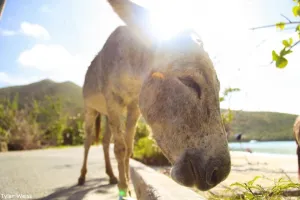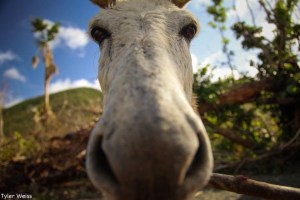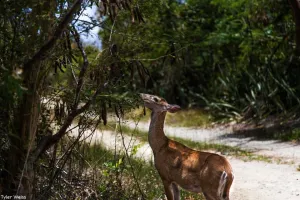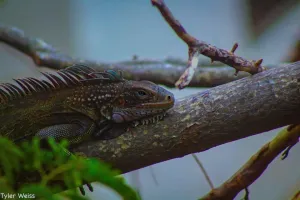Creatures And Critters of the Virgin Islands
Creatures And Critters of the Virgin Islands
Ahoy! Ever wonder about the wildlife meandering about the islands? If so, “Welcome aboard” to this week’s blog about the Creatures and Critters of the Virgin Islands. There are plenty of interesting facts about those cute and furry critters as well as the creepy, crawly ones to snag your attention.
Everyone’s Favorite Animals
If you’ve ever been to the island of St. John, you’ve probably “oohed” and “aahed” over herds of donkeys that roam about the island. Sometimes they’re in groups of two or three, other times there are a half a dozen or more. Often, babies are in tow. You can spot the furry and somewhat temperamental critters on St. John plodding along Centerline Road, eating on the hillsides by Peace Hill, or strolling the sand at Honeymoon Beach. They’re always on the move.
Around 2008, one of my first encounters with Guy Benjamin, the first St. Johnian to finish high school who went on to graduate from New York University and become the Superintendent of Schools on St. John and St. Thomas (He passed away in 2012 at the ripe age of 98), was at his home on the East End near Skinny’s. It was late afternoon and we were chatting about his book, Me and My Beloved Virgin, when he stopped and said, “Listen!”
It was the sound of hooves plodding along the road. In short order, nearly a dozen donkeys of various sizes paraded into Benjamin’s yard, first stopping to drink from a small plastic pool filled with water, then nuzzling their noses into Benjamin’s chest. Clearly, they were friends.
“They come every afternoon,” he explained. “They drink from my little pool and eat fruit from my trees.”


But the donkeys were certainly wary of me, a stranger in their midst. Mr. Benjamin never encouraged tourists to stop and feed the donkeys but he, like the donkeys, had lived on the island long enough to know that a bit of shade, a sip of water and the sweetness of an apple or two were a welcome relief to the intense heat and harsh conditions of the island. Their camaraderie was sweet to witness.

On the other hand, I both cringe and get angry at tourists who stop on the roads and lure donkeys to their cars with sandwiches and potato chips. Too many donkeys have lost their fear of cars which means every year, several of those wild donkeys lose their lives when they step in front of a moving vehicle and get hit.
Donkeys have inhabited St. John since the 1600s when slavery was abolished, resulting in many of the donkeys being set free from the island’s plantations. Some 60+ donkeys are known to inhabit St. John alone. While other islands have wild donkeys, too, their numbers don’t seem to be as plentiful.
St. John Wildlife Rehabilitation encourages you to admire the donkeys from a distance so that they might remain wild. Tempting them to eat your food will break down their natural instincts and they’ll quickly become unwanted pests. Take all the pictures you desire, but don’t get too close as tourists have been kicked and bitten when the animals get spooked. And remember: if you want to picnic on the beach, secure your food or those wandering donkeys might just ruin your plans.
That same summer when I spoke with Mr. Benjamin, I happened to mention that I saw a totally black baby donkey. I wondered how often that happens. “It takes many generations,” he said, adding, “It’s special that you got to witness something so rare.”
In case you’re wondering, a baby donkey, regardless if it’s male or female, is called a “foal.” A young male donkey is called a “colt’ and a young female is a “filly.” A female donkey is known as “jenny” and the name for a male donkey is “jack.” A mule is the offspring of a male donkey and a female horse.
Oh Dear! So many deer!
You might be surprised to learn that St. John, St. Thomas and St. Croix are home territory for some of the most unique white-tail deer on the planet. And yes, rumors about them swimming from island to island are true.
The deer have been here a long time, even mentioned in a Danish ship log as critters that were released on St. Croix during or before 1790. It’s presumed they were brought for hunting purposes and subsequently, in the mid 1800s, the animals were also brought to St. Thomas. Swimming the channel between St. Thomas and St. John became commonplace.

Then in the 1950s, the USDA created a program that brought deer to the islands from Texas and the Carolinas. With no natural predators, the deer population quickly mushroomed. St John reportedly had some 2000 deer roaming the island before 2015, when a severe drought caused the numbers to drop.
Because deer are protected from hunting within Virgin Islands National Park, they have become quite used to humans and show little fear as they eat their way through the forests and hotel grounds. While farmers on St. Croix can get special permits to remove deer if they are persistently destroying crops, little has been done throughout the Virgin Islands to stem the population explosion, leading to serious tree decimation.
Eleanor Gibney, an expert on plant native species, spoke with St. John Tradewinds back in 2017 about the deer’s eating habits which are changing the forest composition. She said that it’s “mind-blowing” how much damage the animals have done. “There are areas where there’s nothing below the browse line. No seedlings. Nothing.”
Of particular concern is the deer’s penchant for eating mangroves. Without mangrove seedlings, the islands are less likely to recover quickly from hurricane damage.
Although tourists find the herds of deer picturesque and adorable, the consequences of their unmanaged care could prove to be a major headache for the islands’ sustainability. For now, though, their continued presence seems assured.
What’s that you say? Is it Mongoose? Mongeese? Or Mongooses?
The first time I spied a mongoose scurrying across the road on St. John I thought it was a weasel. It was dark brown, long and very fast. Gone so quickly that I wasn’t really sure what I had seen, I soon learned it was a mongoose.
Brought to the Virgin Islands in the 1800s as a solution to control the rat population on sugar plantations, this small, carnivorous animal, originally from Asia and Africa, has easily adapted to the Caribbean landscape. Ironically, though, the mongoose has done little to stem the rat population as the mongoose is active during daylight and rats forage at night.
The small Indian mongoose found in the Virgin Islands is very weasel-like with a slender dark brown body, short legs and small rounded ears. From head to tail, they can grow to three-and-a-half feet long. Mongooses are strong, active hunters who live in rock crevices and holes and eat everything from small ground creatures and eggs to fruits and vegetables. They also will raid trash bins along the beach to eat whatever leftovers beachgoers have left behind. Visit the Virgin Islands National Park and you’re sure to see a few darting in and out of the bushes.
While the mongoose, known for its ability to kill snakes, is often depicted in children’s literature as cute and cunning, ecological groups consider it a dangerous pest because of its negative impact on native species. In the Virgin Islands, the animal is responsible for putting several lizards and snakes on the extinction list. With no known predators and a high rate of reproduction (they can produce 36 offspring in just four years), ecologists warn that their presence could negatively affect the landscape of the islands for years to come.
The Roaming Herds
While wild pigs have been spotted on various islands, the largest group of roving animals you’ll see throughout the Virgin Islands, especially on St. John, consists of sheep and goats. Coral Bay area, in particular, seems to attract wandering herds of both animals.
Some say the sheep belong to the heirs of Gerda Marsh, a long-time resident of the East End who died in 1995, but I suspect the goats and sheep stem from various owners and some are simply feral. Although picturesque, neither animal is native to the island and therefore can cause damage to indigenous plants. Rumor is that goats are not tolerated within the National Parklands and when captured by using traps or corrals, the meat is distributed to the local community as goat meat is a delicacy of island cuisine.
Travel to St. Croix and you’ll see many different types of goats raised on the island for both their milk and their meat, though there, too, you’ll spy a few goats who have escaped their confines to feed on greener pastures. Even Jost Van Dyke, one of the British Virgin Islands, has a collection of wild goats and sheep that flit about, as well as a few horses that don’t appear to have owners! (Book a boat trip with Stormy Pirates and you might just get to see them for yourselves!)
Green With Envy?
It’s hard to imagine the Virgin Islands without iguanas as they seem to be everywhere, but they most likely migrated to the Caribbean from Central and South America. Studies conducted on the Green Iguana, the species found in the U.S.V.I., suggest that this type of lizard has migrated to various islands via “rafts.”


After a hurricane in 1995, a collection of Green Iguanas was found on Anguilla, an island that previously had never seen the reptile. It’s believed that the newly-introduced species arrived via a clump of tree debris – a natural raft – which traveled some 200 miles away from its original location. There’s also evidence to suggest that Amerindians might have introduced them to the islands as a food source. (While traveling in Grenada, my guide once told me that iguanas “taste like chicken!” I can’t confirm, though, as I’ve never tried to eat one.)
Green Iguanas, contrary to their name, are not always green, though young iguanas are easily recognized by their fluorescent green color. Older iguanas tend to have darker coloring resembling olive green. Some species can grow to five-feet in length from head to tail.
Although Green Iguanas can swim with some proficiency, they are most adept at climbing. Observing them brings to mind acrobats in a circus. When they slip and fall, they use their claws to grasp branches which help them to land without getting hurt.
Although iguanas look very dinosaur-like and are known to defend themselves from predators by striking with their tails, they generally flee from humans. If captured by their tails, they can allow their tails to break because they will eventually grow back. Unfortunately, iguanas love to lay on warm surfaces like roads, so their greatest predators are cars, though you’ll hardly find an islander who feels sorry for their demise as they are known to eat entire hillsides of flowers and vegetation to satisfy their immense appetites.
Native VS Nonnative – The Endless Battle
As you might have surmised by now, most of the familiar creatures and critters of the Virgin Islands are not native species. In fact, the only endemic land mammal found in the U.S.V.I. is the bat. Six different species, actually, including the red fig-eating bat, greater bulldog bat, Jamaican fruit-eating bat, Antillean fruit-eating bat, velvety free-tailed bat, and the Brazilian free-tailed bat. All of the donkeys, goats, sheep, pigs, and mongooses are non-native species.
Striking a balance between the native and nonnative species is definitely the challenge to ensure a healthy ecological future for the islands. While I can’t imagine the Virgin Islands without wandering donkeys or goats, I also don’t want to see the natural landscape decimated. Let’s hope environmentalists can find a solution that maintains a healthy balance between those cute picturesque animals and the lush, verdant landscape that we’ve come to admire.
End Notes: We hope you’ve enjoyed learning about a few creatures and critters of the Virgin Islands and encourage you to share the posts with your friends. If we’ve tickled that “I’ve-got-to-visit-the-islands’ desire, please visit our web site so we can help you make the most of your trip. Book a boat day with Stormy Pirates and we will happily put the gang plank down and escort you in style!
